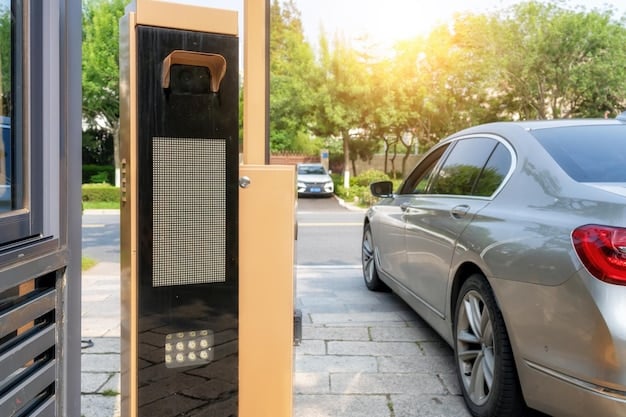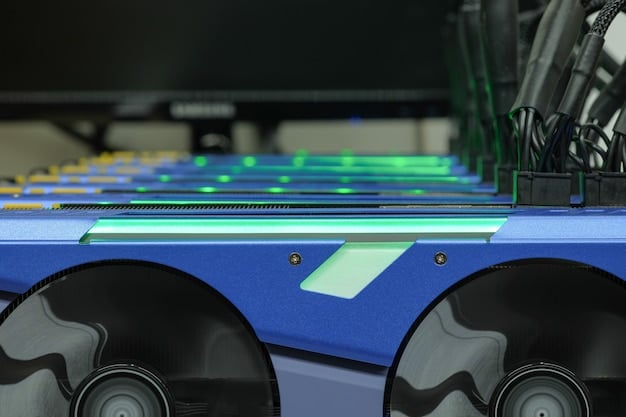Solid-State Batteries in US EVs: Real-World Performance Analysis

Solid-state batteries in US electric vehicles promise enhanced energy density and safety, but their actual performance and long-term reliability under diverse driving conditions require thorough evaluation to understand if they deliver on their potential benefits.
Are solid-state batteries the future of electric vehicles in the US? The promise of higher energy density, faster charging, and improved safety has generated significant buzz. But what’s the real-world performance of new solid-state batteries in US electric vehicles, and are they ready to replace traditional lithium-ion?
Understanding Solid-State Battery Technology
Solid-state batteries represent a significant leap in battery technology, offering potential advantages over traditional lithium-ion batteries. These advancements could revolutionize the electric vehicle (EV) industry in the US. But what exactly makes them different?
Let’s delve into the core differences and potential benefits.
Key Differences from Lithium-Ion Batteries
Traditional lithium-ion batteries use a liquid electrolyte to facilitate the movement of ions between the anode and cathode. Solid-state batteries, as the name suggests, replace this liquid electrolyte with a solid material, such as ceramics, glass, or polymers.
Potential Benefits for Electric Vehicles
The shift to a solid electrolyte offers numerous potential benefits:
- Higher Energy Density: Solid-state batteries can potentially store more energy for a given size and weight, leading to longer driving ranges for EVs.
- Improved Safety: The solid electrolyte is less flammable than liquid electrolytes, reducing the risk of fires and thermal runaway.
- Faster Charging: Solid-state batteries may allow for faster charging times compared to lithium-ion batteries.
- Longer Lifespan: The solid electrolyte can be more stable, potentially leading to a longer lifespan and more charge cycles.
These potential benefits make solid-state batteries a highly attractive option for the future of EVs in the US, promising increased range, safety, and convenience.
Current State of Solid-State Battery Development
While solid-state battery technology holds immense promise, it’s important to understand the current stage of its development and the challenges that remain. The technology is still relatively new and faces hurdles before widespread adoption.
Several companies are actively engaged in research and development.
Leading Companies and Their Approaches
Numerous companies are investing heavily in solid-state battery technology. Some notable players include:
- QuantumScape: Focusing on solid-state lithium-metal batteries.
- Solid Power: Partnering with major automakers to develop sulfide-based solid-state batteries.
- Toyota: Pursuing solid-state battery technology for hybrid and electric vehicles.
Challenges and Roadblocks to Mass Production
Despite the progress, significant challenges remain:
- Cost: Manufacturing solid-state batteries is currently more expensive than lithium-ion batteries.
- Scalability: Scaling up production to meet the demands of the EV market is a major hurdle.
- Performance: Achieving consistent performance and long-term stability is crucial for commercial viability.
Overcoming these challenges is essential for solid-state batteries to become a mainstream technology in US electric vehicles.
Real-World Performance Metrics: What to Expect
Understanding the real-world performance of solid-state batteries is crucial for assessing their potential impact on the EV market. While lab tests provide valuable data, actual driving conditions present different challenges.
Let’s explore the key performance indicators.
Energy Density and Range
Energy density is a critical factor in determining the range of an EV. Solid-state batteries have the potential to significantly increase energy density, leading to longer driving ranges.
In practical terms, what does this mean for drivers?
A higher energy density translates to more miles per charge. Early tests suggest a potential increase of 50-80% in range compared to current lithium-ion batteries. However, these figures can vary depending on driving conditions and vehicle type.
Charging Time and Efficiency
Faster charging times are a major selling point for EVs. Solid-state batteries could enable significantly faster charging due to their improved thermal stability and ion conductivity.
How quickly can these batteries charge?
Some manufacturers claim that solid-state batteries can charge from 0 to 80% in as little as 15 minutes. This would dramatically reduce the downtime associated with charging, making EVs more convenient for everyday use.
Safety and Stability
Safety is a paramount concern for EV owners. The non-flammable nature of solid electrolytes in solid-state batteries offers a significant safety advantage over lithium-ion batteries, which can experience thermal runaway and fires.
What makes them safer?
The solid electrolyte eliminates the risk of leakage and reduces the potential for short circuits. This enhanced safety profile could boost consumer confidence and accelerate the adoption of EVs.
Factors Influencing Performance in US Driving Conditions
The performance of solid-state batteries can vary depending on several factors, particularly the diverse driving conditions found in the US. From extreme temperatures to varying road surfaces, these elements can impact battery performance.
Let’s consider these influences.
Temperature Sensitivity
Temperature extremes can significantly affect battery performance. Cold weather can reduce battery capacity and charging speed, while high temperatures can accelerate degradation. However, solid-state batteries generally exhibit better thermal stability compared to lithium-ion batteries.
Driving Habits and Terrain
Aggressive driving, frequent acceleration, and hilly terrain can all increase energy consumption and reduce range. Understanding how solid-state batteries perform under these conditions is crucial for predicting real-world performance.
Infrastructure and Charging Availability
The availability of charging infrastructure also plays a crucial role. Even with fast-charging solid-state batteries, limited access to charging stations can still be a barrier for EV adoption. The US needs to continue expanding its charging infrastructure to support the growing number of EVs.

Case Studies and Early Adopter Experiences
While widespread adoption of solid-state batteries is still in the future, some early adopters and pilot programs are providing valuable insights into their real-world performance. These case studies offer a glimpse into what we can expect as the technology matures.
Here are some examples.
Initial Test Results from Automakers
Several automakers have conducted internal tests of solid-state batteries and shared preliminary results. These tests often focus on range, charging time, and safety performance. While the results are promising, it’s important to note that they are typically conducted under controlled conditions.
Feedback from Early Adopters and Pilot Programs
Some companies and government agencies are conducting pilot programs with EVs equipped with solid-state batteries. Feedback from these early adopters can provide valuable insights into the technology’s day-to-day performance, reliability, and durability.
Comparison with Traditional Lithium-Ion Batteries
Comparing the performance of solid-state batteries with that of traditional lithium-ion batteries in real-world driving scenarios is essential. These comparisons can highlight the advantages and disadvantages of each technology and help consumers make informed decisions.
Future Outlook and Potential Impact on the US EV Market
The future of solid-state batteries in the US electric vehicle market looks promising, but several factors will influence their adoption and impact. Continued technological advancements, cost reductions, and infrastructure development are all crucial for realizing their full potential.
The outlook is cautiously optimistic.
Predictions for Adoption and Market Penetration
Experts predict that solid-state batteries could begin to appear in commercial EVs within the next 3-5 years. However, widespread adoption may take longer, depending on the pace of technological advancements and cost reductions.
Potential Impact on Range, Charging, and Cost
If solid-state batteries deliver on their promises, they could significantly increase the range of EVs, reduce charging times, and potentially lower the overall cost of ownership. This would make EVs more appealing to a wider range of consumers.
Policy and Regulatory Considerations
Government policies and regulations can play a crucial role in accelerating the adoption of solid-state batteries. Incentives for manufacturers and consumers, as well as safety standards and environmental regulations, can all influence the pace of adoption.
| Key Point | Brief Description |
|---|---|
| ⚡ Higher Energy Density | Potential for increased EV range compared to lithium-ion. |
| ⏱️ Faster Charging Times | Solid-state batteries could reduce EV charging times significantly. |
| 🛡️ Improved Safety | Reduced risk of fire due to non-flammable solid electrolyte. |
| 💲 Cost Challenges | Current manufacturing costs are higher than lithium-ion batteries. |
FAQ
▼
Solid-state batteries offer increased energy density, improved safety due to non-flammable electrolytes, potentially faster charging times, and a longer lifespan compared to traditional lithium-ion batteries.
▼
Because solid-state electrolyte is non-flammable, eliminating the risk of thermal runaway. Therefore, the battery reduces the possibility of fires and improves the overall safety of electric vehicles.
▼
While not yet widely available, several automakers and battery manufacturers are actively developing solid-state battery technology, with plans to introduce them in EVs within the next few years.
▼
The main challenges include reducing manufacturing costs, scaling up production to meet market demand, and maintaining consistent performance and stability of the batteries over their lifespan. These are key factors for full viability.
▼
By increasing range, improving safety, and potentially lowering costs, solid-state batteries could significantly boost the appeal and adoption of EVs, accelerating the transition to electric mobility in the US. Also reduce the charging time.
Conclusion
While still in the development phase, solid-state batteries hold immense promise for revolutionizing the electric vehicle industry in the US. The potential benefits of increased range, improved safety, and faster charging times could make EVs more attractive to consumers and accelerate the transition to a cleaner transportation future. However, overcoming the remaining challenges related to cost, scalability, and performance will be crucial for realizing their full potential.




